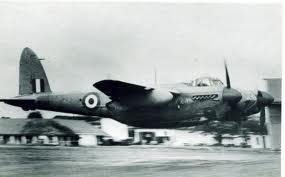 Mosquito Pr 34
Mosquito Pr 34Post World War 2
1945. Dutch-East Indies.
101. In September, 1945, 81 Squadron moved from Bobbili, under the command of Sqn Ldr Kennedy, D.F.C., into Malaya. Its exact location is not recorded, though it may have been Penang, Butterworth or Seletar.
102. In October the squadron was sent to Batavia, in the Dutch East Indies, as part of the forces of occupation.
103. The Indonesians, freed from the Japanese occupation, had no desire to return to Dutch rule. Preferring independence, they proclaimed the new state of Indonesia, and prepared to resist the Dutch by force.
104. The British had no intention of getting involved in this matter, other than concerning itself with the disarmament of the Japanese, and returning them to Japan. In the course of this Indonesian rebels clashed with the British, and the commander of the 49
th Indian Infantry Brigade was murdered.105. The squadron carried out a number of operations in support of 15 Corps, flying sorties against the rebels, which included low-flying attacks on their airfields, and ammunition dumps in October and November. There was little effective Indonesian air activity.
106. The squadron again disbanded, this time on 30
th June, 1946, at Kemajoren, in Java. By this time the Dutch were moving back in, and Army and R.A.F. Units were being withdrawn. The Dutch gave the Indonesians independence in November, 1949.1946-1948 Malaya
107. The squadron was again re-formed on 1
st September, 1946, when No. 684 Squadron, based at RAF, Seletar, Singapore, was re-numbered No. 81(PR) Squadron, equipped with Mosquito Pr 34’s. Thus 81 Squadron, after five years as a fighter squadron, now took up its present role.108. The squadron was engaged in the photographic reconnaissance of Malaya, with a detachment surveying Java, and the Lesser Sundas. In November, 1946, this survey was completed, and the detachment was withdrawn, going on to Mingaladon, in Burma, to complete the survey of Western Thailand. This detachment returned to Seletar in April, 1947.
109. A Spitfire flight of Spitfire Fr 18
’s was also engaged in the survey of Singapore town and harbour, and the Malayan airfields.110. A survey of Sarawak, and British North Borneo was the next task given to the squadron, and a detachment was sent to RAF Labuan for this purpose, operating on a three-day detachment cycle.
111. In August, 1947, two Mosquitos crash landed at Labuan in a typhoon, both crews luckily being unhurt. In September, 1947, aircraft and personnel were withdrawn from Labuan having completed 75% of the task.
 Mosquito Pr 34
Mosquito Pr 34
112. In October, 1947, the squadron moved to RAF Changi, continuing the survey of Malaya, and operating another detachment of three Mosquitos at Mingaladon. This detachment was withdrawn in December, with its task almost complete.
113. In January, 1948, a detachment was sent to RAF Butterworth, Penang, with the task of surveying the Kra Isthmus, and Thai beaches. No. 28 Squadron, one of the two Spitfire squadrons (the other being No. 60) in the Far East, sent six aircraft to Hong-Kong in January via Kuching, and Clarke Field, shepherded by an 81 Squadron Mosquito. This move, a practice of re-inforcement, reflected the growing anxiety over conditions in China, where the dispirited Chinese Nationalists, were quickly losing ground to the Reds.
114. The Mosquito remained at Kai Tak to survey Hong Kong, and the New Territories.
115. It was not only in China that the communist menace was beginning to loom larger. By the end of 1947, the illusory impression that peace was returning to South-East Asia was being dispelled. The occasional murderous attack on Malayan white planters was being recognised as part of an organised insurrection.
116. In May, 1948, a State of Emergency was declared. The Seaforth Highlanders left Gillman Barracks for up-country, and the RAF stood by to give its support.
The Malayan Emergency.
117. 81 Squadron had been caught in the middle of several other commitments. In February, 1948, the squadron moved to RAF Tengah, and another detachment had been sent to RAF Labuan to continue the survey of Sarawak, and North Borneo. In May another detachment was sent to Hong Kong to survey French Indo-China, returning to Tengah in July.
118. Operation
‘Firedog’ began, a code-name covering anti-terrorist operations, which still continue to this day. The first ‘Firedog’ was flown by Spitfires on 9th July, 1948, a detachment being sent to Kuala Lumpur for the purpose.119. In January, 1949, the crew of a Mosquito baled out over Thailand, when their aircraft caught fire, and both were rescued unhurt. At this time all the Mosquitos were based at Tengah, and the Spitfire flight at Kuala Lumpur. Fg. Off. I.M. Pedder, a Spitfire pilot, was awarded the D.F.C.
120. In January, 1950, two Mosquitos collided near Jesselton during a formation fly-past, which was laid on as a show of strength following the assassination of the Governor of Sarawak. All four aircrew were killed, among them being a certain Nav. II Wallace. The four men were buried in Jesselton. From that time on, the mother of Nav.II Wallace continued to correspond with the squadron, sending the aircrew a continual supply of magazines and newspapers, thus keeping alive the memory of her son.
121. In February, 1950, a detachment of four aircraft was sent to Saigon, to continue with the survey of French Indo-China, but this detachment was withdrawn in May, because of the urgency of the
‘Firedog’ commitment in Malaya. All but 1000 sq miles of the total of 49,000 sq. miles had been covered in four months.122. On 15
th, March, 1950, the squadron moved back from Tengah to Seletar. In October of that year, a detachment was sent to Butterworth, for the survey of Southern Thailand, leaving only one Mosquito, and one Spitfire at Seletar, but the following month, the whole squadron was detached to Butterworth, leaving only the squadron Anson at base.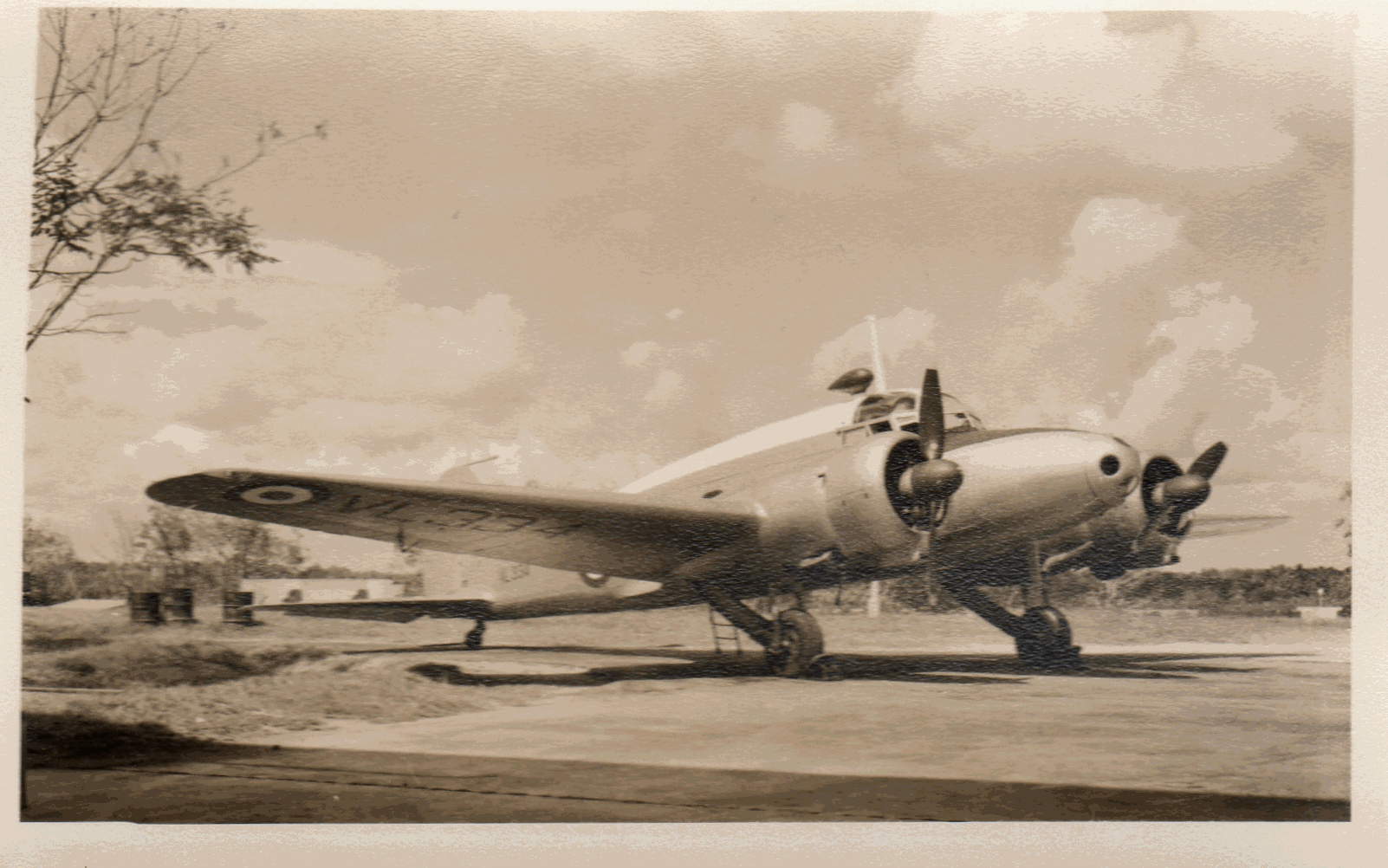 Anson VL 334
Anson VL 334
123. Bruce Robertson’s book ‘Spitfire – The Story of a Famous Fighter’, gives a glimpse of the activities of the PR Spitfires in those days: Although overshadowed by the news from Korea, Spitfires still remained operational for a time in Malaya, being engaged on strikes and reconnaissance’s. In the latter role, Spitfires played an important part, when Dakota KJ-962 was missing after crashing in the jungle during August, 1949.
Photographic reconnaissance missions to detect the terrorist camps were flown at the usual PR heights of between 16,000-17,000. Thereby the bandits were kept unaware of the fact that their camps may have been located by photographs, whereas low level missions might have caused them to shift camps.
124. In January, 1951, five Spitfire 19’s were received from the U.K., of which two left immediately for
Kai Tak. In February, another detachment consisting of one Mosquito was sent to Labuan, remaining there until mid-September, by which time it had completed 23,234 sq, miles of cover.
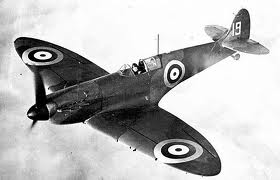 Spitfire 19
Spitfire 19
 Mosquito PR 34
Mosquito PR 34
125. In September, the squadron commander, Sqn Ldr J. Morgan, flying Spitfire PM-574 had complete loss of engine power, and had to ditch 50 yards short of the Seletar runway. Sqn Ldr Morgan was badly hurt, and had to be medically repatriated.
126. On 1st April, 1954, Spitfire Pr 19, PS-888, took off from Seletar on the last operational flight of a Spitfire in the RAF. This fact seems to be generally acknowledged these days, but one still finds authorities (such as Bruce Robertson on page 98 of his book ‘Spitfire’) crediting 60 Squadron with the honour. 60 Squadron flew their last Spitfire operationally on 1st January, 1951. There was a presentation of a silver model by Rolls-Royce and Vickers-Armstrong to 60 Squadron, and a parade, which was improved by the appearance of a formation of 81 Squadron’s Spitfires. Later Vickers Armstrong and Rolls Royce made amends for this mistake by presenting 81 Squadron with another silver model Spitfire.
127. The following letter has also been preserved in the squadron file, and it quoted in full from-
H.Q. Singapore
RAF Seletar
RAF Tengah
Date: - 1st May, 1953
Ref:-81S/S/1/Air
Operational Flying Spitfires
1. Reference is made to the attached cutting from the Singapore Standard dated 1st May, 1953. It is noted that the flying carried out by the Spitfires of No. 81 Squadron, should not have been classified as operational with effect January 1st, 1951, as you are requested to transfer the total of 1874, 25 hours, and 1029 operational sorties from that date to the training columns. Alternatively the squadron will be pleased to accept an 18 inch high silver model of a Spitfire from the commanding Officer of No. 60 Squadron in commemoration of current operations.
(W. P. SWABY)
Squadron Leader
Officer Commanding
No. 81 Squadron
128. From that time on the Mosquito bore the brunt of the reconnaissance work, doing long-range flying to Ceylon in the West (where they supplied the Aircraft for the Film “The Purple Plain), Japan in the north, Christmas Island, and Cocos (Keeling) Island in the south, and Darwin to the east. Over Borneo, they were engaged in anti-piracy patrols, and on one occasion were instrumental in enabling a bunch of pirates to be caught. The basic
‘Firedog’ cover of Malaya was completed in September, 1953, comprising a total of 856 areas, each one measuring 10,000 yards by 20,000 yards.129. In November, 1955, the first Meteor Pr 10s began to arrive, and shortly after this, a couple were deployed to Kai Tak.
130. On 15
th December, 1955, Mosquito PR 34a, PG-314, flew the last operational sorties of a Mosquito in the RAF, another honourable ‘last’ to the credit of 81 Squadron (although honourable ‘lasts’ seem to be a feature of the RAF in the Far East).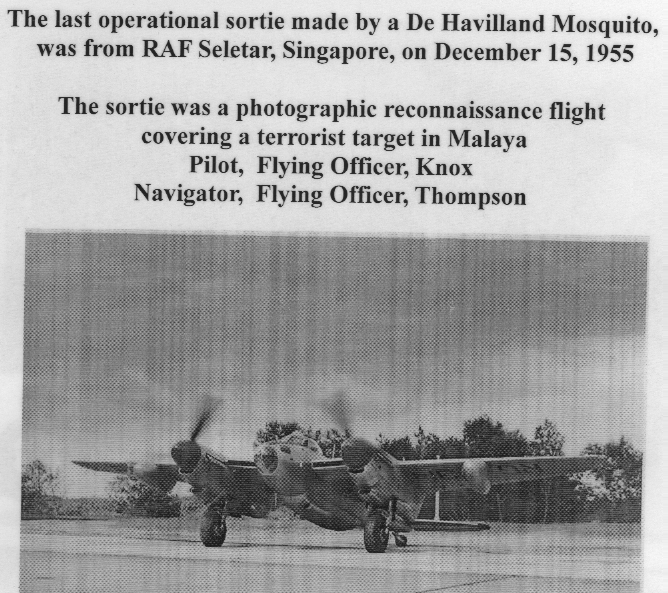
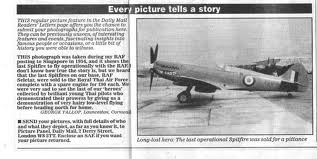
131. The squadron continued to operate with Meteor 10s, although in August 1956, their efforts were supplemented by some Hunting Percival Pembroke C (PR) 1s, which were used for low level work. In April, 1958 the squadron again moved back to RAF Tengah.
 Pembroke
Pembroke
132. On 17
th December, Flg. Off. George Paul flew the 10,000th Firedog sortie was flown in Meteor 10 WB-165. During the ten years of the emergency, the squadron had flown some 9000 sorties against the terrorist, quite apart from non-operational surveys of Malaya, Borneo, Sarawak, Hong Kong, Thailand, Indo-China, and all points east. Three D.F.C.s, three A.F.C.s, and two D.F.M.s had been awarded.
Since the Emergency
133. Although the Emergency in Malaya only gradually receded even today, in 1963, the squadron is still engaged in operations against the remnants of the terrorists.
134. In January, 1960 the first Canberra, the T.4 WH-651, arrived on the squadron. It was followed in February by WH-777, a PR 7, and WH-780 in August. Since then re-equipment has continued until the whole squadron consisted of Canberras. The Pembrokes were flown away by July, 1960, and the last two Meteor 10s left for Seletar M.U. on 7
th July, 1961 (WB-159 and WB-166, flown by Flt. Lt. Littlejohn, and Flt. Lt. Ashley).![]() Canberra WH 791
Canberra WH 791
![]() WH 791 in Newark
WH 791 in Newark
135. 81 Squadron missed being the last RAF squadron equipped with Meteors, as No. 60 Squadron continued to fly NF 14s for a few weeks longer.
136. Squadron Markings. The identification letters ‘FL’ lapsed at the end of the operations in Java. The Mosquitos and Spitfires do not seem to have carried any squadron markings, other than possibly small squadron transfer crests. The ‘Ace of Spades’ design was not revived until the Meteor, and Pembrokes began to carry it again. Because these aircraft were silver, the design had to be modified- the playing card being yellow, with black markings. Some Meteors also carried squadron crest transfers. With the arrival of the Canberras, it was decided to carry a white disc on the fin, with the Red Star and Sword on this.
About November, 1961, this was modified so that the fabric-covered area on the fin was painted black, making the white disc more obvious. Canberra’s carried the yellow ‘Ace of Spades’ also either side of the nose, near the pilot’s canopy.
137. Over the latter part of 1961 and early 1962, 81 Squadron was again engaged in Thai survey. The whole country had been surveyed by Valiant PR aircraft based at Butterworth, but 81 Squadron was employed to fill in the gaps. A pleasant occupation, which took the Canberras over all parts of Thailand, from the Burmese border in the West, to the Laotian border in the North, and the Cambodian border in the East.
An aircraft flew up twice a week, night stopping in Bankok, thus allowing all squadron aircrew to get to know that excellent city on intimate terms. At the conclusion of the task, the Royal Thai Survey Department of the Army, invited all 81 Squadron aircrew, and a selection of ground crew to a party in Bankok.
138. The survey of North Borneo, Sarawak, and Brunei, continued to figure with increasing importance during 1962 and 1963. To the South, Indonesia was apparently eyeing the territories of British Borneo, and it was essential that the survey was completed before trouble broke out in the area. Detachments to RAF Labuan were a frequent occurrence, although the Borneo weather did not allow any startling progress to be made.
139. In December, 1962, came the insurrection in Brunei. 81 Squadron were sent to reconnoitre the area of fighting, and to watch the frontiers with Indonesia,
140. With this event came the order that the survey of all British Borneo was to be given the highest priority, and from May until September, 1963, the whole effort of 81 Squadron was directed to this end, working at times on a seven day week. By the time the worsening weather made any further effort wasteful, about 80% of the area had been covered.
No 81 Squadron finally disbanded as the Far East Air Force was being run down on 16th January 1970.